Packing House District
Introduction
Text-to-speech Audio
From the earliest days of St. Joseph history, meat packing has been an important component of the local economy. Many of the Polish immigrants worked in the packing houses. The district has a rich, and sometimes tragic history, marked by hard work and unspeakable tragedy. The Polish community was at the heart of this history. In May 1930, the Armour Packing House was ripped apart by an explosion killing 19 workers including Frank Wieczorek, the 40-year-old son of Polish immigrants. During the hey-day of the meat-packing industry in St. Joseph, many of the Polish workers lived in the modest residential neighborhoods surrounding the district creating a tight-knight community. As the plants closed, much of the unique character of the Polish district was lost.
Images
Triumph Foods, the site of former packing houses
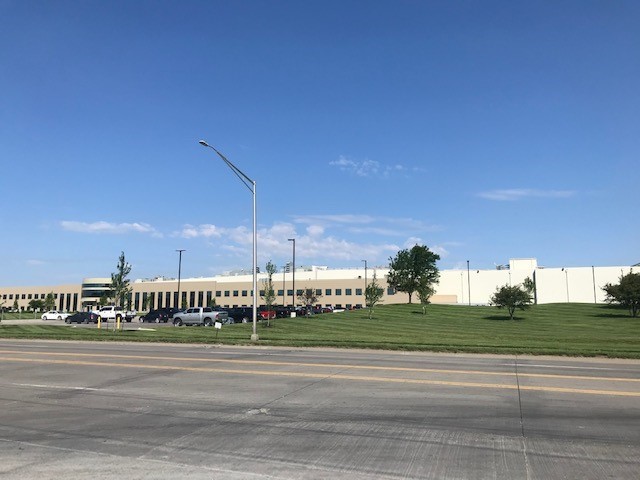
Site of former packing houses
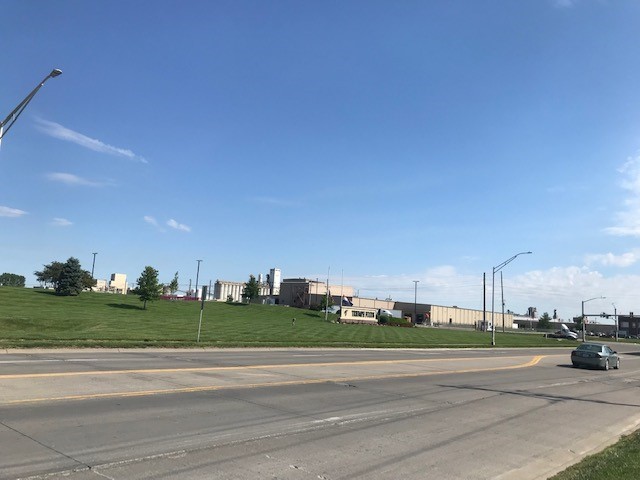
Livestock Exchange Building
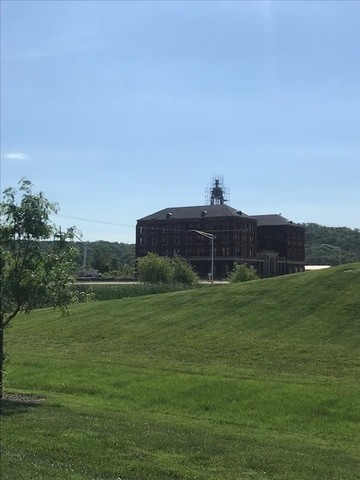
Site of former packing houses

Triumph Foods, site of former packing houses
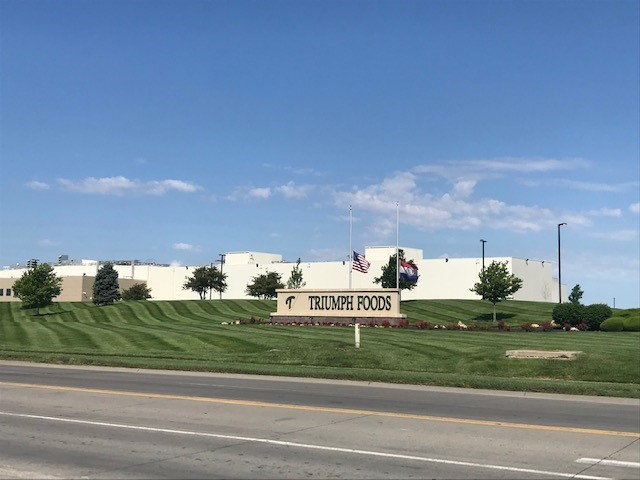
1911 Sanborn Map showing the packing house district
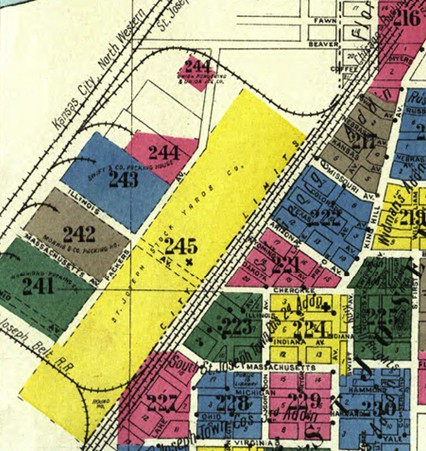
1911 Sanborn Map showing the Hammond Packing House
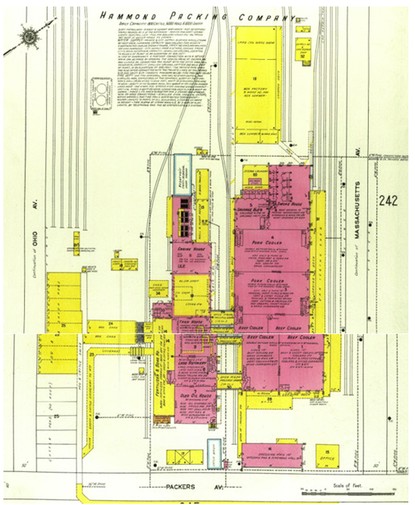
1911 Sanborn Map showing the Morris Packing House
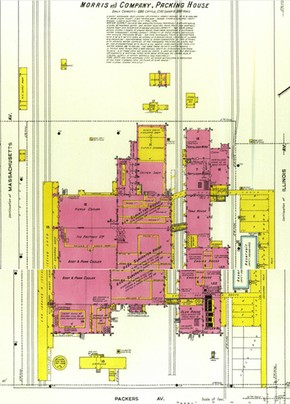
1911 Sanborn Map showing the Swift Packing House
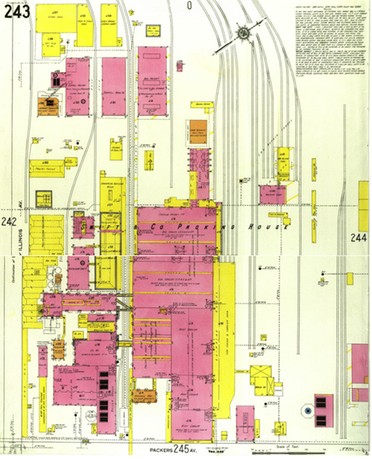
View of the Packing House District in 1898
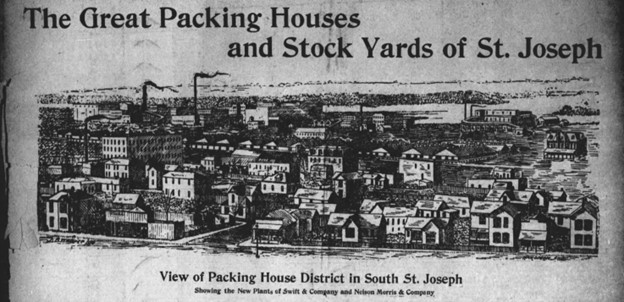
Image of the destruction following the 1930 explosion at the Armour Packing House
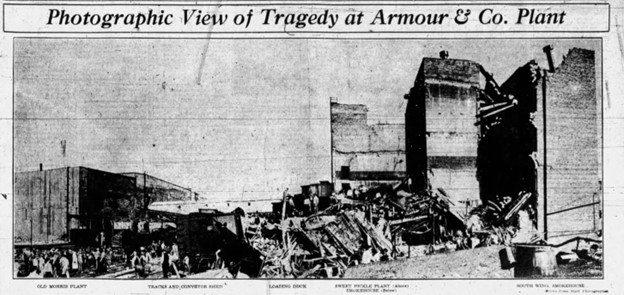
Backstory and Context
Text-to-speech Audio
From its inception, St. Joseph has benefited from its location at a transportation hub. This location facilitated the growth of many industries, but none more than the livestock industry. As early as 1846, John Corby was in the meat packing business. David Pinger operated the most successful of the early meat packing operations. These were located close to the Missouri River in the area where the historic downtown is now located. The Hannibal and St. Joseph Railroad operated a stockyard facility close to its terminal on Walnut Street, a bit south of the main rail station during the 1860s. It functioned essentially as a holding yard for the hogs and cattle being shipped east.
As with everything else in the city, the Civil War disrupted the meatpacking and stockyard business. It took a bit of time after the end of hostilities to re-establish the trade, but Pinger did reopen his business, this time with new partners, William Zook and J.C. Waterman, both of whom were expansion minded.
Once St. Joseph had completed its railroad bridge across the Missouri River in 1873 business expanded and hogs arrived in the city from as far as 100 miles away. In that year, a group of local businessmen decided that there was a real need for a formal stockyard so they created the Union Stock Yards Company. They worked to ensure that the processing of the animals happened in the city rather than having St. Joseph simply serve as a stopping off point. The Company leased five acres near the bridge close to the incoming rail lines. In its first year the new stockyard reported traffic of 69,000 hogs, 24,616 head of cattle, and 1,100 horses.
As St. Joseph entered the last quarter of the nineteenth century, Pinger & Co. remained the leading packing house; however, the Hax Brothers, the Connett Brothers, the Valley Packing Company, and the Henry Krug Packing Company all helped to make St. Joseph a hub of the livestock industry, primarily focusing on the slaughtering of hogs.
The St. Joseph Stockyards company, organized in November 1886, worked to facilitate the transshipment of cattle through the city. One of the primary movers in the creation of the new stockyards was James McCord, who had become rich in the wholesale grocery business. It was that business that made him acutely aware that the small meat processors were being pushed out of business by the large packers such as Armour and Swift, who could provide cheaper, more convenient processed meat. McCord knew that unless St. Joseph attracted the big companies, it would be left in the dust of the changing meat industry. In order to attract those companies, a major stockyards facility was necessary, hence, McCord’s interest in the St. Joseph Stockyards Company. McCord took his proposal to Charles B. France, one of the city’s leading bankers, and convinced him to put up $500,000 in capital. Construction on the pens and the Livestock Exchange Building began in June 1887. This first Exchange building was three stories high and made of brick. Among the first directors of the Stockyards Company were John Donovan, Samuel Nave, Henry Krug Jr., Charles B. France, and J.B. McNeely. The souvenir booklet commemorating the opening of the second Livestock Exchange building described them as “men who not only enjoyed the confidence and respect of this section of the country, but men of ample capital, large business experience, and men whose names stood for strength and who had a reputation of bringing things to pass. In other words, every name connected with this enterprise had made a success in life, and not one of them ever made a failure in any business undertaking.”
In December 1887 the more than 440-acre St Joseph Stockyards opened for business and six rail companies agreed to build spurs to the facility. But the success of the whole enterprise hinged on attracting major packing houses to St. Joseph and that proved to be a challenge. In return for building a processing facility on the site, meat packers were promised 80 acres at no charge. Despite this incentive, none of the major Chicago companies immediately agreed to locate in the new yards. Facing the loss of their investment, the stockholders decided to build a packing plant themselves, eventually leasing it to Allerton & Co. a small packing concern out of Chicago. In 1889, the City of St. Joseph loaned the Stockyard investors the funds to build a beef processing plant that Anchor Beef Packing Company then leased. Anchor failed three years later and a New York consortium that formed the St. Joseph Packing and Transportation Company purchased the facility.
Soon after this, the Stock Yard Company reorganized as the St. Joseph Stockyards and Terminal Company and that entity built a third packing plant. At this time, John Donovan, the President of the newly reorganized company, traveled to Chicago to meet with representatives from the major packing companies, but he did not succeed in convincing any of them to open operations in St. Joseph. This lack of support from the major meatpacking companies and the financial turmoil of the mid-1890s resulted in the failure of all of the packing houses built by the stockyards, a financial setback that led the stockyards company to be placed into receivership.
The St. Joseph Stockyards sprang back to life in 1897 when Swift & Co., one of the nation’s largest meat packing companies, purchased the majority of stock in the stockyards company. The company was then reorganized under the original name, the St. Joseph Stock Yards Company. Swift & Co. sold part of the controlling interest in the stockyards company to Nelson Morris & Co. and both packing companies began construction on large packing plants in the St. Joseph Stockyards complex. That same year, Hammond Packing Company signed an agreement to build an immense packing plant on the site. They had leased a smaller plant that was already in place, but the success led them to commit real resources to St. Joseph. The newly built plant had a daily capacity of 2,000 hogs, 800 cattle, and 200 sheep. It employed 1,000 workers. Armour & Co. purchased this facility in 1912. In 1898, in order to meet the needs of the expanded packing houses, the stockyards themselves were enlarged and improved. Under Swift’s ownership, John Donovan was the day-to-day boss of the company. He was known in the city as the most consistent cheerleader for the stockyards and packing house industry.
In the period between 1897 and 1900, huge changes were made to the livestock business in St. Joseph. The Stockyards Company reorganized, three new packing houses were built under their aegis, the stockyards themselves modernized and enlarged – the plans done by E.J. Eckel, and a new Livestock Exchange Building was constructed. These advancements marked the real beginning of the great success for St. Joseph’s livestock and meatpacking industries. In July 1900 a special issue of the St. Joseph Journal of Commerce reported:
The packinghouse district has been like the Phoenix of old, only it has not sprung from its ashes, but from the wreck it had fallen in 1896 and 1897. In the space of three years, it has grown from insignificance as a packing center to be one of the great factors in this line. . . In 1897 came the great awakening of St. Joseph. In August of that year, Swift and Company, the great packers. . . broke ground for their new plant, followed almost immediately by Nelson Morris & Co. almost eight months after these two great packers opened their plants for business, in March 1899, the Hammond Packing Company commenced work on their new plant. . . When in April 1900 they opened for business, people realized that St. Joseph was on a sound foundation having the three most modern packing houses in the world. The capacity of these mammoth plants are 5,000 cattle, 15,000 hogs, 10,000 sheep and 10,000 poultry daily. . . The packing business in dollars in St. Joseph amounts to about one-half of the business transacted here yearly.
The St. Joseph stockyards was the fifth largest market in the United States, behind Chicago; Kansas City, Kansas; South Omaha; and New York. It held this position through the first half of the 20th century. In 1899 the yards had a capacity to house 25,000 hogs, 18,000 cattle, and 8,000 sheep daily. It was St. Joseph’s largest industry, employing more than 4,500 area residents. In this era, South St. Joseph quickly developed into its own self-contained city. In 1911, there was a move by St. Joseph to expand the city limits so as to bring the stockyards and the Livestock Exchange within the boundaries. The Stockyards Company opposed this annexation, arguing that the market and the packing centers were built without the financial assistance of St. Joseph and thus the area should not be burdened with the requirements imposed by city government and responsibility for its debt. The resolution in opposition read in part: “We can confidently assert that the success of our undertaking is the principal element in the growth and prosperity of the city of St. Joseph, having brought to our market about $500,000,000 in payment for livestock sold here and more than $60,000,000 as wages distributed among its working men.” Despite this opposition, the City of St. Joseph went forward with the annexation.
Not surprisingly, with the large workforce employed at the yards and packing houses, there were instances of labor unrest in the area. In late 1921 the Amalgamated Meat Cutters and Butcher Workmen of North America called a strike. The St. Joseph News-Press reported that most of the workforce reported for work and that the places of those who did stay out of the packing houses were quickly replaced. Taking no chances, the City of St. Joseph deployed extra police to ensure that no violence occurred.
A number of terrible accidents happened in the packing houses. In August 1898, a lightening strike caused part of the Hammond Packing House to burn, resulting in the serious injury of two firemen. The same facility was struck by fire again in July 1903. The fire killed two men and injured three others. The most devastating of the accidents was the explosion at the Armour (formerly Hammond) Plant in May 1930. At 3:15 pm a huge blast from the vast ammonia tanks ripped through the smokehouse. It was said that the explosion came without warning and that the workers had no chance to escape. The final count was 19 dead; six women and 13 men. Many of the victims lived in the residential areas around the packing house district.
In 1918, the St. Joseph Stockyards had its highest total yearly receipts – 4,087,650 head of livestock were sold through the facility. In 1919, the number dropped to just over 3,000,000, and sustained at this level until 1961. Unfortunately, the gradual closing of both the Swift and Armour plants between 1965 and 1983 was a severe setback for both the stockyards and to the St. Joseph economy overall. The shuttering of the plants put huge pressure on the stockyards because their business was almost entirely slaughter animals destined for those plants. In 1995, Ed Czerwein, the St. Joseph Stockyards manager cited changes in transportation and legislation in the 1920s as the beginning of the decline for stockyards nationwide. Anti-trust legislation of the 1920s forced the packing plants out of the stockyards business. The St. Joseph Stockyards ended operations in 2021; however, meatpacking remains a large industry in the area with large concerns such as Triumph operating successfully.
Sources
Terry Raffensperger, “Geography Helped Make St. Joseph a Meat-Packing Town,” St. Joseph News-Press, Nov. 5, 1995; Armour Takes Over Hammond Plant,” St. Joseph News-Press, July 18, 1912; “Improvements Going On,” St. Joseph News-Press, April 6, 1898; “Most Workers Refuse to Quit Packing Houses,” St. Joseph News-Press, Dec. 5, 1921; “Struck by Lightning,” St. Joseph Weekly Herald, Aug. 4, 1898; “Costly Fire at Hammond Plant,” St. Joseph News-Press, July 6, 1903; “14 Dead, 3 Missing in Blast at Plant of Armour Company,” St. Joseph News-Press, May 9, 1930; “Workers Trapped as Blast Wrecks Plant,” Farmers’ Weekly Review, May 14, 1930; “Pitiful Scenes at Factory Gate as Word is Awaited,” St. Joseph News-Press, May 9, 1930; “Nineteen Lives Snuffed Out,” St. Joseph Observer, May 15, 1930
